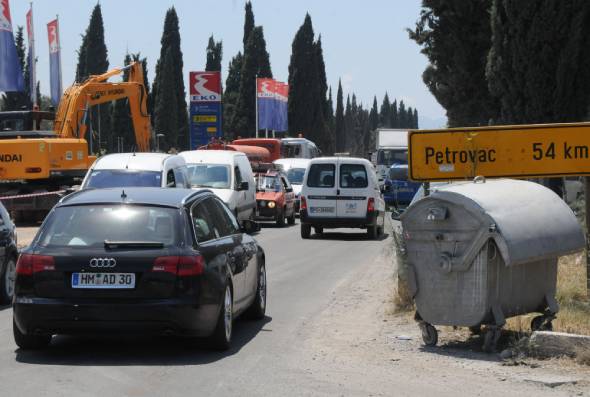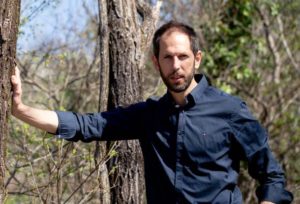Coronavirus pandemic and restricted people's movement leading to huge drop in air pollution: COVID cleans what people pollute

In addition to the Thermal Power Plant Pljevlja and the Aluminum Plant Podgorica, apart from the heating season, the largest pollutants are more than 240 thousand vehicles, most of which are over 10 years old, with the largest percentage being diesel cars. WHO's calculations show that six percent of all deaths in Podgorica, 12 percent in Nikšić and 22 percent in Pljevlja can be attributed to the effects of air pollution
The irony brought by COVID-19 is that the air in Montenegro is significantly cleaner.
This is mainly due to the limited traffic, the forced parking of most of the 240,000 registered vehicles, more than two-thirds consuming diesel. More than half of all vehicles are between ten and 20 years old, and a fifth even up to three decades old.
According to a research carried out by the Center for Investigative Journalism of Montenegro (CIN-CG), other pollutants are Aluminum Plant Podgorica, Thermal Power Plant Pljevlja and the unfinished heating season.
Prevention from the spread of the pandemic has also affected global trends, as shown by satellite imagery of significantly reduced pollution above industrial zones in Europe and other parts of the world.
IQAir, a Swiss-based air quality technology company, has conducted a study of the world's ten most polluted cities which revealed that extensive preventative measures have reduced air pollution by 30 to 60 percent.
In Podgorica, over the past month, the number of dangerous particles causing pulmonary, cardiac and malignant diseases has exceeded the limit of 50 micrograms per cubic meter (μg / m3) on eight days only. This was confirmed on the website of the Environmental Protection Agency of Montenegro (EPA Montenegro), where air quality data is updated daily. The highest level of pollution by PM10 (particles less than 10 micrograms composed of the mixture of smoke, soot, acid, heavy metals) was recorded on 21 March, amounting to 144.8, while the level of PM 2.5 particles (2.5 micrometers in diameter, or three percent diameter of human hair) was 123.1 μg / m3.
In contrast to these results, a PM 2.5 level of over 350 μg / m3 was recorded in Podgorica in mid-January. According to a method developed by Richard Muller, a professor of physics at the University of California, this is equivalent to smoking 16 cigarettes a day. He and his daughter, Elizabeth, climate change and air pollution activist, carried out an extensive research in China in 2015 and concluded that smoking one cigarette a day is equal to the detrimental effect of breathing air in which the hazardous PM 2.5 particles are 22 micrograms per cubic meter. (http://berkeleyearth.org/air-pollution-and-cigarette-equivalence/).
Concentrations of harmful PM10 particles at metering stations in Podgorica exceeded 510 micrograms per cubic meter in early January, and according to Agency's official data for December, the air in Podgorica, Bijelo Polje and Pljevlja was polluted almost every day. In Nikšić, this average was slightly milder, with extremely high concentrations of these particles observed on 16 December being: (i) PM 2.5 - 609.3 and (ii) PM 10 - 721.2; which is 12 to 14 times more than the allowed daily average value of 50 micrograms.
Exceeding the average pollution level should not be over 35 days per year. Pljevlja had 136 such days during last year and 129 the previous year. Nikšić had 61 days in 2019, and in 2018 as many as 79 days, while Podgorica had 75 days in 2018, and in last year 57 days above the allowed mean values. In Bijelo Polje, measurements began only last year and comparative data from 2019/20 indicate that it is more polluted than Pljevlja during the heating season from 1 October to 1 April.
The Environmental Protection Agency (EPA) explained for CIN-CG that poor air quality during winter months in the central and northern regions has become commonplace, listing industrial activity, traffic and the heating season as the main causes.
"High air pollution episodes, primarily suspended particles (PM10 and PM2.5), are characteristic during the winter months when weather conditions, with high atmospheric pressure, slow down the circulation of air, bringing dry, cold and foggy nights. The presence of factors affecting the deterioration of air quality lasts from four months in Podgorica to half a year in Nikšić and Pljevlja. According to EPA, during these time periods, the total annual number of overruns of mean daily values of suspended harmful particles is concentrated, except in cases of accident situations.
At the end of last August, the Agency started publishing daily air quality reports for the most polluted areas of Podgorica, Nikšič, Bar, Pljevlja, Bijelo Polje, Kotor, Gornje Mrke and Gradina.
In January, when media, NGOs and opposition politicians called in question the ongoing pollution levels and the inert attitude of the institutions, the Agency stated that "the law prohibits unauthorized interpretation of results that could be misleading and cause misinformation of citizen." The problem is that there was no "authorized interpretation of the results".
"Air pollution in Montenegro has a seasonal nature and it is most often related to the heating season. Thus, the solutions must be aimed at establishing a district heating system in urban areas, implementing energy efficiency measures in residential and collective housing facilities, strict implementation of environmental standards in the industry, vehicle modernization, improvement of urban transport and a number of other activities'', the Agency noted.
Despite improved situation in the past month, the Agency's data shows an increase in the surpassing of the daily average of PM10 by 1 April compared to the previous season in Podgorica and Nikšić. The biggest pollution in Podgorica is recorded at the roundabout in Zabjelo, one of the largest concentrations of cars in the capital.
Biologist Vuk Iković says that the Thermal Power Plant causes 41 percent of total nitrogen oxide emissions, while the Aluminum Plant accounts for 41 percent of all polluting PM10 particles.
"The official data indicates that Pljevlja is the largest ecological black spot. The data clearly demonstrates that its water, soil and air are polluted. This is due to the Thermal Power Plant, the Coal Mine, “Vektra Jakić“, the slag and ash landfill ''Maljevac'' and the waste and tailings landfill ''Jagnjilo'', Iković told CIN-CG.
Iković also warns of the serious consequences of the huge number of cars, most often old and diesel fueled. Only in Podgorica, more than 70 thousand cars are registered.
“The green light for pedestrians lasts shorter than for vehicles. The highest concentration of toxic particles is at the intersections, one meter above ground surface. That is why children and people in wheelchairs suffer the most. Public transport is not organized yet. There is no quick communication from the suburbs to the city center. The system forces citizen to buy a car instead of encouraging them to use other modes of transport'', Iković says.
In Montenegro, 246,423 vehicles were registered in the past year: 6,193 motorcycles, 215,496 cars, 462 vans, 1,461 buses, 17,282 freight vehicles, 576 specialized and commercial vehicles, 1,662 towing vehicles, 3,090 trailers and 201 tractors.
According to the information provided by the Ministry of Internal Affairs, oil or diesel is consumed by 180,153 vehicles, super 98 petrol by 54,678, petrol 86 by 515, fuel blends by 14, petrol-gas combination by 7,854 vehicles, while only 144 cars are electrically powered.
There were 459 registered ‘old-timers’, manufactured until 1979. As many as 10,428 were from the SFRY (1980 to 1989). From the last decade of the last millennium, there is a total of 43,186 registered vehicles.
There are 134,653 vehicles manufactured between 2000 and 2010. Most of them are manufactured in 2004 and 2007 - 15,573 and 15,937 respectively.
From 2010 to the end of 2019, between 4,200 and 7,867 cars have been imported annually, amounting to a total of 57,607 new cars.
According to the Customs Administration, over the past year, the largest number of imported used cars were diesel fueled - 14.088, while only 1.020 were gasoline cars. Also imported were 2,225 new gasoline powered cars, 1,363 diesel cars and only 25 electric ones.
The Customs Administration explains that, according to the Law on Road Safety and the current rulebook on technical requirements, it is not allowed to import used vehicles that do not meet the EURO 4 standard. New vehicles should be equipped with minimum EURO 6 engine and meet the requirements for exhaust emission limits and noise levels.
In Germany, a partial ban for EURO 4 diesel vehicles was introduced in some cities last April. That is why protests have been organized and the cities of Hamburg, Berlin, Stuttgart and Darmstadt have reported more than 16,000 people violating the ban on the use of older "non-environmental" diesel cars.
The Institute of Public Health did not reply to our request for data on how air pollution affects health. Unofficially, there is no such recent research, so the one that the Institute conducted in late 2015 and early 2016, in collaboration with experts from the World Health Organization (WHO), is still relevant. Air pollution assessment study covering Pljevlja, Podgorica and Nikšić revealed that more than 250 premature deaths and 140 hospital admissions annually in these three cities, as well as a number of other health consequences, are directly linked to the increased exposure to PM particle concentrations.
WHO's calculations show that six percent of all deaths in Podgorica, 12 percent in Nikšić and 22 percent in Pljevlja are attributable to the effects of air pollution above the values prescribed by this institution. The Institute previously told CIN-CG that the annual rate of premature mortality associated with exposure to pollutant particles in Montenegro, is up to 60 times higher than the tragic consequences of traffic accidents and up to 20 times higher than mortality due to diseases of the digestive system.
World Health Organization data indicates that air pollution is a global public health challenge that kills seven million people a year!
Iković considers necessary to introduce a pollution tax. This implies payment for the release of pollutants into the air, primarily carbon, nitrogen and sulfur oxide, soot etc.
"It is possible for us to become an EU member with this kind of air quality, but then we will have to pay the costs of pollution. For example, for every tone of CO2 emission, we would pay 25 euros. If Montenegro manages to regulate key pollutants and conserve and recover its forests, it could earn millions, as its nature would reduce pollution levels beyond borders. This should be our offer to Europe. This is one of the reasons why Podgorica should be a tree-city, for which we have launched an initiative of 100,000 new trees'', Iković says.
Aleksandar Perović, from the NGO Ozon, points out that air is an important segment of Chapter 27 in the EU negotiation process.
"So far, this international organization has not shown much interest for the problem of air pollution, which is very surprising to us, given that clean air is one of the fundamental human rights. If this attitude is not changed, it is hard to expect that domestic decision makers will take any action“, Perović told CIN-CG.
Asked by CIN-CG whether the implementation of Chapter 27 obligations was threatened by air pollution, the Agency replied that "the Approximation Strategy and the adoption of initial negotiation benchmarks have defined and proposed deadlines for activities to reduce air pollution".
According to the Environmental Protection Agency, "air pollution does not jeopardize the fulfillment of Chapter 27 commitments, but prompts finding the best possible solutions to this problem."
Hazardous tire and waste incineration
Old furniture, layers of debris, concrete, earth and gravel, electronic and plastic waste, food scraps and used tires are found in Podgorica's settlements: Stari Aerodrom, Vrela Ribnička or parts of Ćemovsko Polje. Residents of these settlements regularly report to the competent bodies the levels of arson and smoke spreading through the settlements and the city.
"Tire and plastic incineration releases one of the most toxic substances, dioxin. Part of it is inhaled and the rest goes into the atmosphere, returning with the first rains and depositing in soil and water. The question is what the purpose of the inspectorate is, if it does not punish the perpetrators”, Iković says.
According to the Law on Waste Management, penalties for unconscientious persons range up to 40 thousand euros for legal entities and up to 2 thousand euros for natural persons. This does not stop the perpetrators, mainly because the responsible bodies can only apprehend those whom they caught violating the law.
Iković recommends that if individuals burn tires due to the sale of steel wire, it should be prohibited to buy it without a proof of origin of such waste.
Neighbors also are among the most polluted
IQAir's list of the 100 most polluted cities from 15 April 2020 includes the Balkan capitals.
Sarajevo ranked 11th as the world's most polluted city, Belgrade 61st, Skopje 85th and Zagreb 94th.
According to the same organization's list of the 100 most polluted countries in the world, Bosnia and Herzegovina ranked 14th, North Macedonia 17th, Serbia 32nd, while Croatia ranked 51st. Slovenia and Montenegro are not included in this list.
According to IQAir, the most polluted city in the world is Shenyang in China.
Europe's most polluted country, according to GreenMatch, is Turkey, followed by Poland and Latvia. The countries with the cleanest air are Sweden, Finland and France.
Air pollution drops in metropolises
During coronavirus lockdown, air pollution in major global cities fell by up to 60 percent in comparison to the last year, CNN reports, referring to the IQAir's data.
Seven out of the ten cities studied, including New Delhi, Seoul, Wuhan and Mumbai, saw significant improvements in air quality from the same period last year.
The Indian capital New Delhi saw a 60% reduction in PM2.5 levels from 23 March to 13 April. The Chinese city of Wuhan, where the deadly virus was first identified, saw a 44% reduction in air pollution levels from 26 February to 18 March.
Los Angeles saw its longest stretch of clean air on record, over 18 days from 7 to 28 March. PM2.5 concentration levels were down by 31%.
In Europe, London, Madrid and Rome experienced during their lockdown periods reductions in their PM2.5 in comparison with 2019.
The reconstruction of the Thermal Power Plant is delayed
The ecological reconstruction of the existing block of TPP "Pljevlja" was supposed to be completed by the next year, but due to the pandemic, it will be delayed since the contract has not been signed yet.
At the beginning of November last year, EPCG declared the winner of the tender for this deal - a consortium of Chinese company Dongfang Electric International (DEC) of Podgorica-based firm Bemaks, BB Solar Company owned by Blažo Djukanović, the son of the President of Montenegro, and Permonte Company, whose bid price was 54,427,700 euros. The German consultant Steag Energy Services hired by EPCG previously estimated that the tender is worth 45 million euros, or 54,450,000 with VAT. Other tenderers’ bid prices were significantly higher: Shangai Electric Group Co.Ltd - 97,922,683 euros and Hamon-Rudis - 72,539,500 euros, but this did not prompt EPCG to raise suspicions, which should normally happen when the range between bids is so large.
Representatives of the Chinese corporation were supposed to arrive in February to agree and sign a contract, but this was delayed, allegedly, due to the Corona epidemics, as their delegation would have to stay in quarantine. EPCG later announced that they were expecting them in March, but Chinese Ambassador to Montenegro Liu Jin said in an interview for “Vijesti” on 15 April that "both sides are in the process of preparing to sign the treaty" and expressed hope that it would be done as soon as possible.
"The project includes, together with the revitalization of the Maljevac landfill worth around 20 million euros, construction of a desulphurization system, a denitrification system, improvement of the operation of the electro filter plant and construction of a wastewater treatment system. Along with the ecological reconstruction, within 12 months from the signing of the contract, a source of thermal energy for heating Pljevlja will be provided”, EPCG stated during the announcement of the tender winners, adding that after the ecological reconstruction, all emissions and products of combustion of coal and chemical processes in accordance with national legislation and European directives, will be kept below the permissible limits.
New analysis of the Health and Environment Alliance (HEAL), Sandbag, Climate Action Network Europe (CAN Europe), the CEE Bankwatch and the Europe Beyond Coal from 2019, has shown that 16 outdated coal-fired power plants in the Western Balkans represent a health and economic liability for the whole Europe.
This report shows that every year, air pollution from Western Balkans coal power plants is responsible for 3,900 premature deaths, 8,500 cases of bronchitis in children and other chronic illnesses. The health issues these plants cause add up to lost productivity and health costs of up to 11,535 million euros.
Predrag NIKOLIĆ




